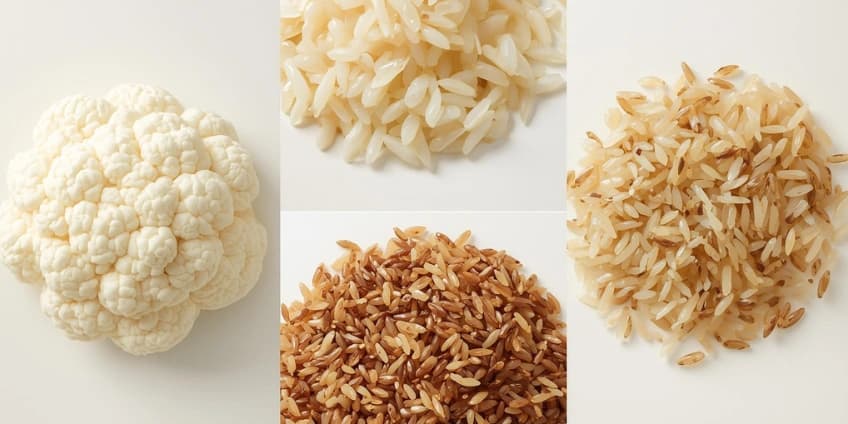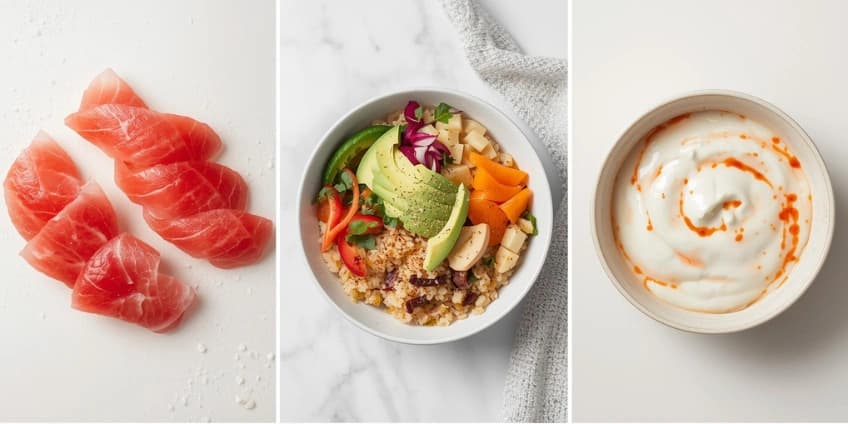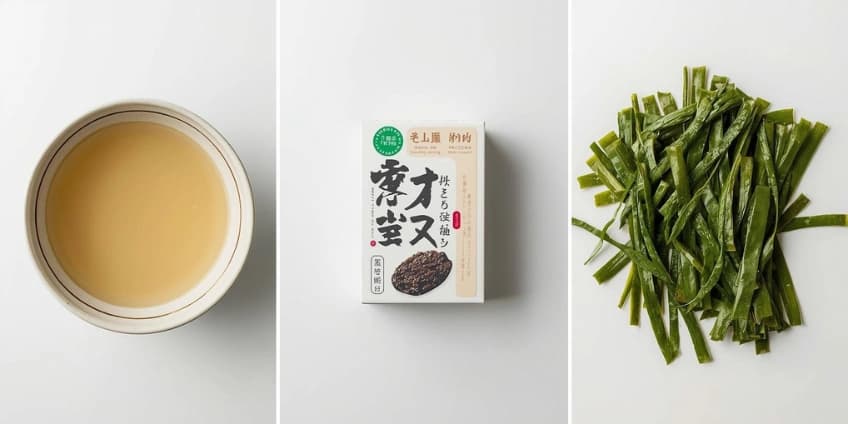🇯🇵 The Ultimate Guide to Healthy Japanese Cooking Swaps

Part of our International Cuisine Swaps Guide series
Japanese cuisine (washoku) is celebrated worldwide for its elegance, balance, and health benefits. From delicate sushi to hearty ramen, crispy tempura to umami-rich miso soup, Japanese food embodies harmony between taste, nutrition, and beauty.
Traditional Japanese cooking is already quite healthy, emphasizing fresh ingredients, seasonal vegetables, and balanced portions. But restaurant versions and Americanized dishes can be heavy on rice, fried foods, sodium, and sugar.
This comprehensive guide covers 50+ Japanese cooking swaps that honor traditional washoku principles while supporting your health goals. These techniques work for home cooking and restaurant favorites alike. いただきます! (Itadakimasu - Let's eat!) 🇯🇵🍣
🍚 Rice & Grain Swaps

Rice is the foundation of Japanese meals. Here are thoughtful alternatives.
Complete Rice Alternatives Guide
| Traditional Rice | Healthy Swap | Calories (per cup) | Carbs | Best For | Texture |
|---|---|---|---|---|---|
| White Sushi Rice (200 cal) | Cauliflower Rice | 25 | 5g | Poke bowls, donburi | Light, veggie-forward |
| White Rice | Shirataki Rice | 10 | 3g | Side dish, rice bowls | Chewy, unique |
| White Rice | Brown Rice | 215 | 45g | Side dish, onigiri | Nuttier, more fiber |
| White Rice | Half White + Half Cauliflower | 115 | 25g | Gradual transition | Best of both |
| Sushi Rice | Quinoa (seasoned) | 220 | 39g | Sushi rolls | Higher protein |
| Sticky Rice | Konjac Rice | 15 | 4g | Low-carb option | Very low calorie |
🎯 Rice Pro Tips
Cauliflower "Sushi" Rice:
- Pulse cauliflower to rice-size grains
- Microwave 5 minutes, pat dry
- Season with rice vinegar + monk fruit + salt
- Result: Surprisingly authentic for poke bowls
Shirataki Rice Preparation:
- Rinse thoroughly 2-3 minutes
- Dry-fry in pan 2-3 minutes (critical step!)
- Season with furikake or soy sauce
- Must dry-fry or texture is rubbery
Half-and-Half Rice Strategy:
- Mix 1 cup white rice + 1 cup cauliflower rice
- Cook white rice as normal
- Fold in cauliflower rice at end
- Best for beginners adjusting to swaps
🍜 Noodle Swaps

Japanese noodles come in many forms. Here are the best alternatives.
Noodle Alternatives Guide
| Traditional Noodle | Healthy Swap | Calories (per serving) | Carbs | Best For | Cooking Tip |
|---|---|---|---|---|---|
| Ramen Noodles (188 cal) | Shirataki Noodles | 10 | 1g | Ramen, soups | Rinse well, dry-fry |
| Ramen Noodles | Zucchini Noodles | 20 | 4g | Light ramen | Add at end |
| Ramen Noodles | Kelp Noodles | 18 | 4g | Cold noodles | Crunchy, mineral-rich |
| Udon Noodles (210 cal) | Shirataki Udon | 10 | 3g | Udon soup | Already similar texture |
| Soba Noodles (113 cal) | 100% Buckwheat Soba | 113 | 24g | Cold soba | Gluten-free, authentic |
| Yakisoba Noodles | Cabbage (shredded thin) | 22 | 5g | Stir-fries | Quick cook, crunchy |
🎯 Noodle Pro Tips
Ramen with Shirataki:
- Prepare rich broth (this is key!)
- Rinse and dry-fry shirataki
- Assemble bowl: broth + shirataki + toppings
- Strong broth compensates for different noodle texture
Zoodle Ramen:
- Add zucchini noodles LAST (30 seconds in hot broth)
- Don't overcook or they'll be mushy
- Use spiralizer for consistent thickness
Cold Soba Swaps:
- 100% buckwheat soba is naturally low-carb
- Rinse in cold water after cooking
- Serve with light dipping sauce (reduce sugar)
🥢 Soy Sauce & Seasoning Swaps

Soy sauce is ubiquitous but high in sodium. Balance flavor and health.
Sauce & Condiment Alternatives
| Traditional Sauce | Healthy Swap | Sodium (per tbsp) | Best For | Flavor Profile |
|---|---|---|---|---|
| Regular Soy Sauce (920mg) | Low-Sodium Soy Sauce | 575mg | All dishes | 38% less sodium |
| Regular Soy Sauce | Tamari (gluten-free) | 780mg | Gluten-free cooking | Richer, smoother |
| Regular Soy Sauce | Coconut Aminos | 90mg | Soy-free option | 90% less sodium, slightly sweet |
| Teriyaki Sauce (690mg) | Homemade Teriyaki | 300mg | Glazing, marinades | No corn syrup |
| Ponzu Sauce (high sodium) | Homemade Ponzu | 250mg | Dipping, dressings | Fresh citrus |
| Mirin (sweet rice wine) | Sake + Monk Fruit | 0 | Cooking | No added sugar |
| Tonkatsu Sauce (high sugar) | Homemade Version | 50mg | Fried foods, rice | Reduced sugar |
🎯 Sauce Pro Tips
Homemade Teriyaki Sauce (No Corn Syrup):
```
1/2 cup low-sodium soy sauce
1/4 cup water
2 tbsp monk fruit sweetener (or 3 tbsp coconut sugar)
2 tbsp sake or mirin
1 tsp fresh ginger, grated
1 clove garlic, minced
1 tsp cornstarch + 1 tbsp water (slurry)
Simmer all except cornstarch 5 min.
Add slurry, stir until thick.
Authentic taste, 60% less sugar!
```
Homemade Ponzu:
```
1/4 cup fresh yuzu juice (or lemon + lime)
1/4 cup rice vinegar
2 tbsp low-sodium soy sauce
1 tbsp mirin (or sake + monk fruit)
1 piece kombu (optional, umami)
Mix together. Refrigerate 24 hours.
Fresh, citrusy, less sodium!
```
Mirin Replacement:
- 1 tbsp sake + 1/2 tsp monk fruit = 1 tbsp mirin
- Adds sweetness without sugar spike
🍤 Tempura & Fried Food Swaps

Japanese fried foods are light but still fried. Here are healthier methods.
Fried Food Alternatives
| Traditional Method | Healthy Swap | Fat Reduction | Technique | Crispiness |
|---|---|---|---|---|
| Deep-Fried Tempura | Air-Fried Tempura | 80% less oil | 400°F, 10-12 min | Very crispy |
| Deep-Fried Tempura | Oven-Baked Tempura | 75% less oil | 425°F on wire rack | Crispy |
| Tempura Batter | Panko + Egg White | Less oil absorption | Bake or air-fry | Extra crunchy |
| Tonkatsu (fried pork) | Baked Panko Pork | 70% less fat | 425°F, press panko | Crunchy coating |
| Karaage (fried chicken) | Air-Fried Karaage | 75% less oil | Marinate, air-fry | Juicy inside, crispy outside |
| Tempura Oil | Avocado Oil Spray | 90% less oil | Light coating | Just enough for crispiness |
🎯 Tempura Pro Tips
Air-Fryer Tempura Technique:
- Dip vegetables/shrimp in light tempura batter
- Spray with avocado oil
- Air-fry at 400°F for 10-12 minutes
- Flip halfway through
- Result: Crispy, 80% less oil
Panko Baked "Fried" Method:
- Coat protein in flour → egg white → panko
- Place on wire rack over baking sheet
- Spray generously with oil
- Bake at 425°F until golden
- Key: Wire rack allows air circulation
Karaage Marinade (Then Air-Fry):
```
2 tbsp low-sodium soy sauce
1 tbsp sake
1 tsp ginger, grated
1 clove garlic, minced
Marinate chicken thighs 30 min
Coat with potato starch
Air-fry 375°F for 15 min
Crispy without deep frying!
```
🍱 Sushi & Sashimi Swaps

Sushi can be healthy but watch the rice and sauces.
Sushi Component Swaps
| Traditional Element | Healthy Swap | Calories Saved | Best For |
|---|---|---|---|
| White Sushi Rice | Cauliflower Rice (seasoned) | 175 cal | Poke bowls, chirashi |
| White Sushi Rice | Brown Sushi Rice | 15 cal | Traditional rolls |
| White Sushi Rice | Half rice + half cauliflower | 90 cal | Gradual transition |
| Tempura Roll | Cucumber Avocado Roll | 200 cal | Fresh, crunchy |
| Spicy Mayo | Greek Yogurt + Sriracha | 60 cal | Sauce |
| Eel Sauce (high sugar) | Reduced-Sugar Version | 40 cal | Drizzle |
| Imitation Crab | Real Crab or Salmon | 0 cal | More protein, authentic |
| Cream Cheese (Philly rolls) | Avocado | 50 cal | Healthy fats |
🎯 Sushi Pro Tips
Cauliflower Sushi Rice:
- Pulse cauliflower very fine
- Microwave 5 min, squeeze dry
- Season like sushi rice:
- Works best for poke bowls, not traditional rolls
Sushi Rice Reduction:
- Ask for "light rice" at sushi restaurants
- Make rolls with 50% less rice
- Load up on fish and veggies instead
Healthiest Sushi Choices:
- Sashimi (no rice)
- Nigiri (thin layer of rice)
- Cucumber rolls
- Salmon/tuna rolls (simple)
- Avoid: Tempura rolls, cream cheese rolls, mayo-heavy rolls
🍲 Miso & Soup Swaps

Miso soup is already healthy. Keep it that way.
Soup & Broth Swaps
| Traditional Element | Healthy Swap | Sodium Reduction | Best For |
|---|---|---|---|
| Regular Miso Paste | Low-Sodium Miso | 30% less | Miso soup, marinades |
| Excess Miso | Use Less + Dashi | Same flavor, less sodium | All miso dishes |
| Instant Dashi (high sodium) | Homemade Dashi | 70% less sodium | Soups, sauces |
| Ramen Broth (restaurant) | Homemade Lighter Broth | 60% less sodium | Ramen |
| Tonkotsu (pork bone broth) | Chicken Broth-Based | 40% less fat | Ramen |
🎯 Miso & Soup Pro Tips
Homemade Dashi (Umami Base):
```
4 cups water
1 piece kombu (dried kelp)
1 cup bonito flakes (katsuobushi)
Soak kombu in water 30 min
Heat water to just before boiling
Remove kombu
Add bonito flakes, steep 5 min, strain
No added sodium!
```
Miso Soup Technique:
- Make dashi base
- Add tofu, wakame, scallions
- Turn off heat
- Whisk in miso paste (don't boil or enzymes die!)
- Key: Add miso at end, low heat
Ramen Broth Lightening:
- Use chicken broth instead of pork bone
- Add kombu for umami depth
- Season with low-sodium soy + ginger
- Skip the pork fat topping (mayu)
🥗 Japanese Salad & Side Swaps
Japanese sides are often naturally healthy. Optimize them.
Dressing & Side Swaps
| Traditional Element | Healthy Swap | Calories Saved | Technique |
|---|---|---|---|
| Sesame Dressing (heavy) | Light Sesame Dressing | 80 cal | Use tahini + rice vinegar |
| Goma Dressing | Homemade Version | 60 cal | Less oil, same flavor |
| Deep-Fried Gyoza | Steamed or Pan-Fried | 100 cal | Steam first, crisp bottom only |
| Edamame (salted heavily) | Light Salt Edamame | 0 cal | Use flaky sea salt |
| Sunomono (cucumber salad) | Already healthy! | 0 | Keep as is |
🎯 Salad Pro Tips
Light Sesame Dressing:
```
2 tbsp tahini
2 tbsp rice vinegar
1 tbsp low-sodium soy sauce
1 tsp monk fruit sweetener
1 tsp sesame oil
2 tbsp water (thin to consistency)
Whisk together. 60% fewer calories than bottled!
```
Gyoza Technique (Crispy Without Frying):
- Steam gyoza 6-8 minutes
- Heat non-stick pan with 1 tsp oil
- Place steamed gyoza flat side down
- Cook until golden crispy bottom
- Result: Juicy + crispy, minimal oil
🍢 Classic Japanese Dish Makeovers
Here's how to transform beloved Japanese classics.
Recipe Transformation Guide
1. Chicken Teriyaki
Traditional Version: 450 calories per serving
Healthy Makeover: 280 calories
| Traditional Ingredient | Swap To |
|---|---|
| Teriyaki sauce (high sugar) | Homemade teriyaki (monk fruit) |
| Chicken thighs (skin-on) | Chicken breast or skinless thighs |
| Oil for pan-frying | Grill or bake |
| White rice (side) | Cauliflower rice or brown rice |
Technique: Grill chicken, brush with homemade teriyaki at end
2. Ramen
Traditional Version: 800 calories per bowl
Healthy Makeover: 380 calories
| Traditional Ingredient | Swap To |
|---|---|
| Ramen noodles | Shirataki noodles or zucchini noodles |
| Tonkotsu (pork bone broth) | Chicken broth + dashi |
| Chashu pork belly | Grilled chicken breast or soft-boiled egg |
| Mayu (black garlic oil) | Skip or 1/2 tsp sesame oil |
| Excess toppings | Load with bean sprouts, spinach, mushrooms |
Result: Satisfying bowl, 420 fewer calories
3. Tonkatsu (Pork Cutlet)
Traditional Version: 600 calories per serving
Healthy Makeover: 320 calories
| Traditional Ingredient | Swap To |
|---|---|
| Pork loin (fried) | Pork tenderloin (baked) |
| Deep frying | Bake at 425°F on wire rack |
| Panko + egg | Same, but spray with oil before baking |
| Tonkatsu sauce (high sugar) | Homemade reduced-sugar version |
| White rice (side) | Shredded cabbage + brown rice |
Technique: Panko coating, bake on wire rack, spray oil
4. Tempura
Traditional Version: 450 calories (6 pieces)
Healthy Makeover: 220 calories
| Traditional Ingredient | Swap To |
|---|---|
| Deep-fried in oil | Air-fried or baked |
| Heavy tempura batter | Light batter (cold sparkling water) |
| Vegetables + shrimp | More vegetables, less shrimp |
| Tentsuyu dipping sauce | Light dashi + low-sodium soy |
Result: Crispy vegetables, 50% fewer calories
5. Sushi Rolls
Traditional Version: 350 calories per roll
Healthy Makeover: 200 calories
| Traditional Ingredient | Swap To |
|---|---|
| White sushi rice | Half rice + half cauliflower |
| Tempura shrimp | Fresh shrimp or crab |
| Spicy mayo | Greek yogurt + sriracha |
| Cream cheese | Avocado |
| Eel sauce | Reduced-sugar version |
Pro Tip: Order sashimi or nigiri instead of rolls
6. Yakitori
Traditional Version: 280 calories (already healthy!)
Healthy Makeover: 220 calories
| Traditional Ingredient | Swap To |
|---|---|
| Chicken thighs | Half thighs + half breast |
| Tare sauce (sweet) | Reduced-sugar tare |
| Chicken skin skewers | Skip or share |
| Salt-grilled (shio) | Already healthy! Keep it |
Note: Yakitori is naturally healthy—just watch the sauce sugar
🌿 Japanese Ingredients (Already Healthy!)
Many traditional Japanese ingredients are nutritional superstars. Use more!
Superfoods to Embrace
Nori (Seaweed):
- High in iodine, vitamins A & C
- Nearly zero calories
- Use in sushi, soups, snacks
- Furikake seasoning (nori + sesame)
Miso (Fermented Soybean Paste):
- Probiotic powerhouse
- Umami-rich, flavorful
- Choose low-sodium versions
- Gut-health benefits
Edamame:
- Complete plant protein
- High in fiber, folate
- Light salt only
- Perfect snack
Shiitake Mushrooms:
- Immune-boosting properties
- Meaty texture, umami flavor
- Rich in vitamin D
- Use in soups, stir-fries
Daikon Radish:
- Aids digestion
- Very low calorie
- Grate fresh for garnish
- Use in salads, pickles
Wakame (Seaweed):
- Rich in minerals
- Supports thyroid health
- Use in miso soup, salads
- Practically zero calories
Tofu:
- Plant-based protein
- Versatile texture (silken, firm)
- Absorbs flavors
- Essential Japanese ingredient
Matcha (Green Tea Powder):
- High in antioxidants (EGCG)
- Metabolism-boosting
- Use in drinks, desserts
- Ceremonial vs culinary grades
⚠️ Common Japanese Cooking Swap Mistakes
❌ Mistake #1: Boiling Miso
Why it fails: High heat destroys beneficial enzymes and probiotics.
The fix:
- Turn off heat before adding miso
- Whisk miso in small bowl with broth first
- Add to pot, stir gently
- Never boil after adding miso
❌ Mistake #2: Heavy-Handed Soy Sauce
Why it fails: Soy sauce is very high in sodium.
The fix:
- Use low-sodium soy sauce
- Add at END of cooking (more flavor, less needed)
- Balance with rice vinegar, citrus
- Use ginger, garlic, dashi for depth
❌ Mistake #3: Not Dry-Frying Shirataki
Why it fails: Shirataki noodles/rice stay rubbery and watery.
The fix:
- Rinse thoroughly 2-3 minutes
- Dry-fry in pan 2-3 minutes minimum
- Pat dry before using
- Critical step for good texture
❌ Mistake #4: Overcomplicating Swaps
Why it fails: Japanese food is about simplicity and quality.
The fix:
- Focus on quality ingredients
- Don't over-season
- Let natural flavors shine
- "Less is more" in Japanese cooking
❌ Mistake #5: Skipping Dashi
Why it fails: Dashi is the umami foundation of Japanese food.
The fix:
- Make homemade dashi (easy, 5 minutes)
- Use as base for soups, sauces
- Boosts flavor without sodium
- Essential ingredient (not optional)
❌ Mistake #6: Wrong Rice Preparation
Why it fails: Poorly prepared cauliflower rice is watery.
The fix:
- Pulse to fine grains (not puree)
- Microwave first, then pat dry
- Season well (rice vinegar, salt)
- Use for bowls (not traditional sushi rolls)
🎯 The Japanese Cooking Swap Formula
Every successful Japanese swap follows this formula:
Quality Ingredients + Simplicity + Umami Base + Respect for Tradition = Washoku
Example 1: Ramen Success
❌ Bad Swap: Watery broth + rubbery shirataki (disappointing)
✅ Good Swap: Rich dashi broth + dry-fried shirataki + soft egg + veggies (satisfying)
Why it works: Strong broth compensates for noodle swap
Example 2: Sushi Success
❌ Bad Swap: Cauliflower rice in traditional rolls (falls apart)
✅ Good Swap: Cauliflower rice in poke bowl or chirashi (perfect vessel)
Why it works: Uses cauliflower where it works best
Example 3: Tempura Success
❌ Bad Swap: Mushy baked vegetables (sad)
✅ Good Swap: Air-fried crispy panko vegetables (crunchy, golden)
Why it works: Air-fryer creates crispiness without oil
📋 Quick Reference: Japanese Swap Cheat Sheet
Top 10 Essential Japanese Swaps
| Need to Replace | Best Swap | Why |
|---|---|---|
| White sushi rice | Cauliflower rice (poke bowls) | 90% fewer carbs |
| Ramen noodles | Shirataki noodles (dry-fried) | 90% fewer carbs |
| Regular soy sauce | Low-sodium soy sauce | 38% less sodium |
| Deep-fried tempura | Air-fried tempura | 80% less oil |
| Teriyaki sauce | Homemade (monk fruit) | 60% less sugar |
| Tonkatsu (fried) | Baked panko pork | 70% less fat |
| Regular miso | Low-sodium miso | 30% less sodium |
| Spicy mayo | Greek yogurt + sriracha | 60% fewer calories |
| Instant dashi | Homemade dashi | 70% less sodium |
| Mirin (sweet) | Sake + monk fruit | No added sugar |
🍽️ Sample Japanese Menu (Healthy Swaps)
Appetizer:
- Edamame with light salt
- Sunomono (cucumber salad with rice vinegar)
Soup:
- Miso Soup with tofu, wakame, scallions (homemade dashi, low-sodium miso)
Main Dishes:
- Chicken Teriyaki (grilled, homemade reduced-sugar sauce)
- Salmon Sashimi (5 pieces)
- Vegetable Tempura (air-fried)
Sides:
- Brown Rice (1/2 cup) or Cauliflower Rice
- Pickled Ginger (gari)
Dessert:
- Fresh Fruit or Matcha with almond milk
Total Meal Calories: ~550 (vs traditional Japanese restaurant ~900)
🏆 Washoku Principles (Japanese Dietary Guidelines)
Even with healthy swaps, honor these Japanese culinary traditions:
1. Ichiju-Sansai (一汁三菜)
- One soup + three sides + rice
- Balanced, complete meal
- Variety of flavors/textures
2. Hara Hachi Bu (腹八分)
- Eat until 80% full
- Okinawan longevity secret
- Practice mindful eating
3. Shun (旬) - Seasonal Eating
- Eat what's in season
- Freshest ingredients
- Connect with nature's rhythm
4. Mottainai (もったいない)
- Don't waste food
- Use every part
- Respect ingredients
5. Umami (うま味)
- Fifth taste (savory)
- Dashi, miso, soy sauce
- Satisfying without excess
About Our Nutritional Data
All nutritional data in this article is sourced from the U.S. Department of Agriculture (USDA) FoodData Central database. We prioritize accuracy to ensure our swaps are evidence-based and trustworthy. Nutritional values may vary slightly based on brands and preparation methods.
🌍 Explore More World Cuisines
This guide is part of our comprehensive International Cuisine Swaps Guide series.
Discover healthy swaps for cuisines from around the world:
- 🇮🇹 Italian Cooking Swaps
- 🇲🇽 Mexican Cooking Swaps
- 🇨🇳 Chinese Cooking Swaps
- 🇹🇭 Thai Cooking Swaps
- 🇵🇭 Filipino Cooking Swaps
- 🇮🇳 Indian Cooking Swaps
いただきます! (Itadakimasu - Let's eat!) 🍱✨
About the Author

This article was written by Ant Real, the founder of SwapHealthy. As a parent, home cook, and developer, Ant is passionate about making healthy eating accessible and delicious for everyone. He created SwapHealthy to share his personal journey and the science-based swaps his family uses to enjoy their favorite foods in a healthier way.